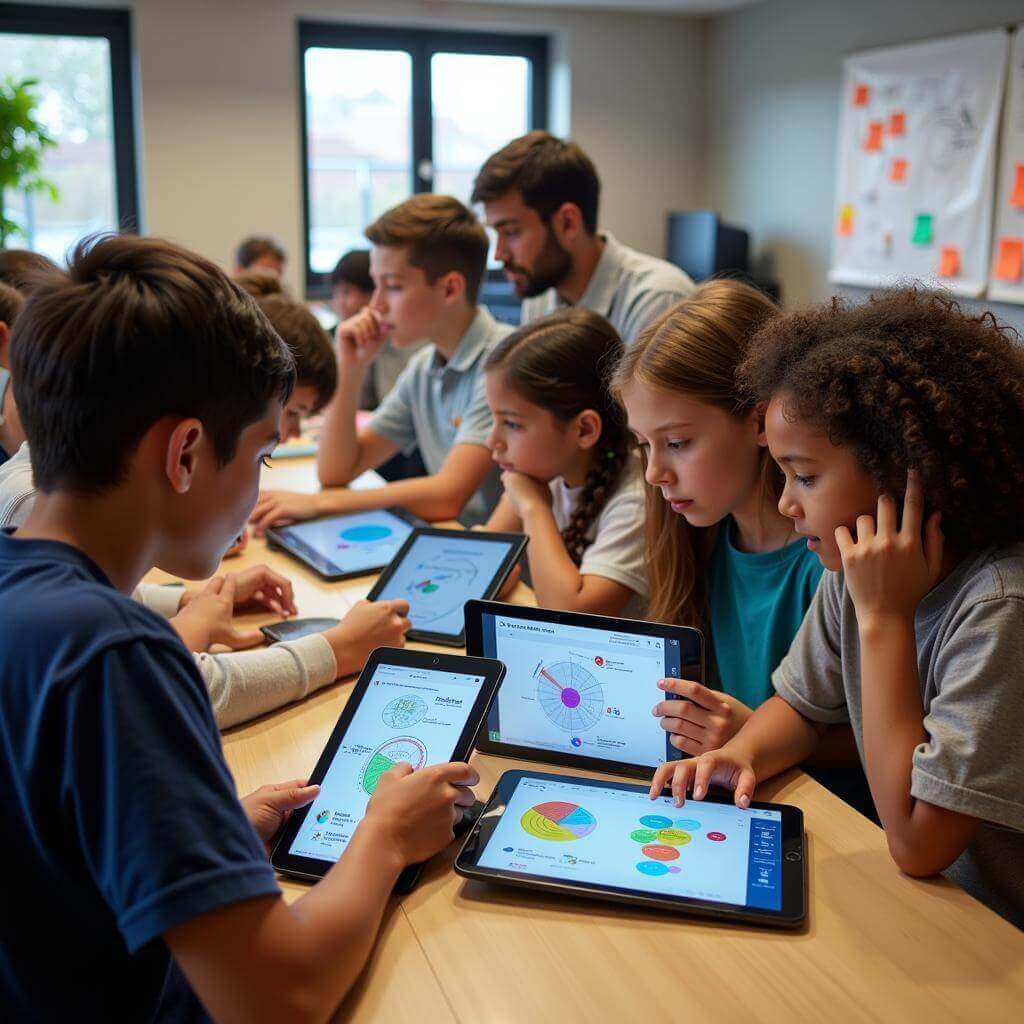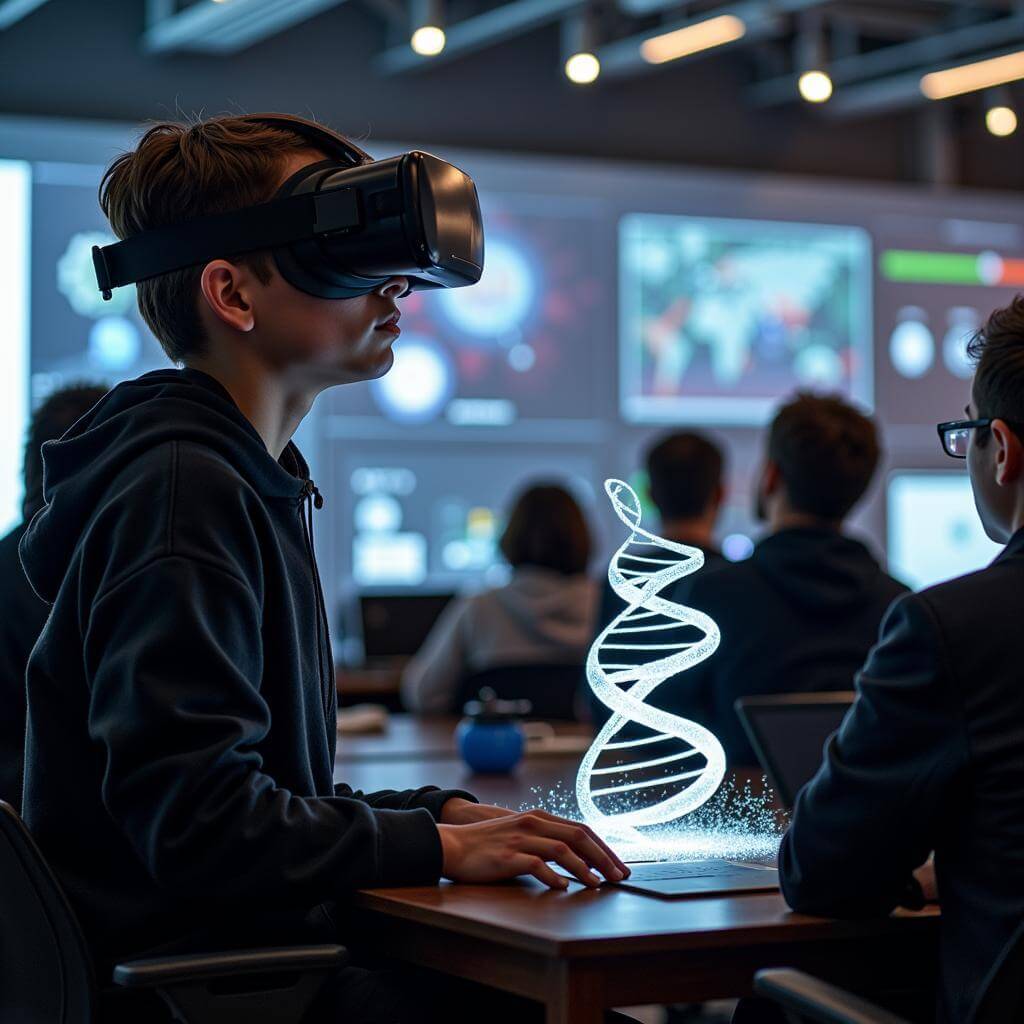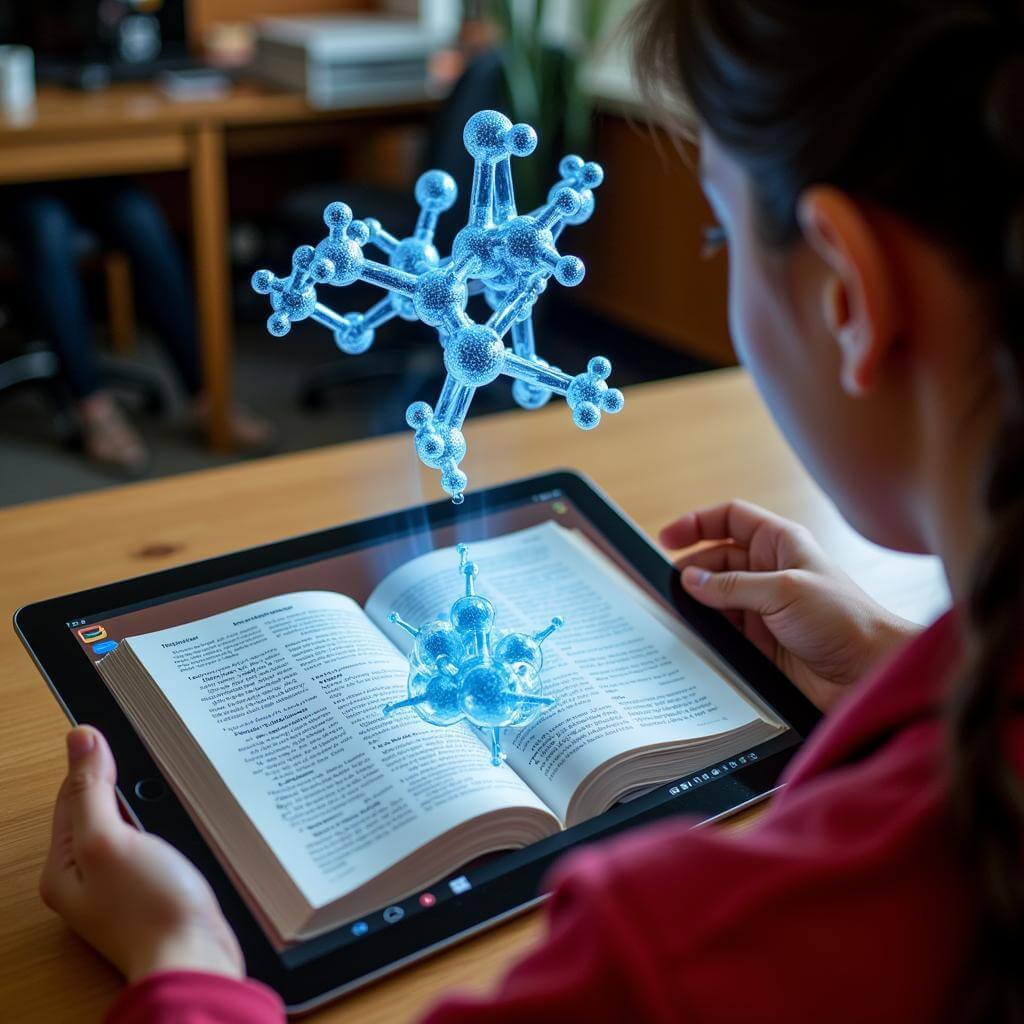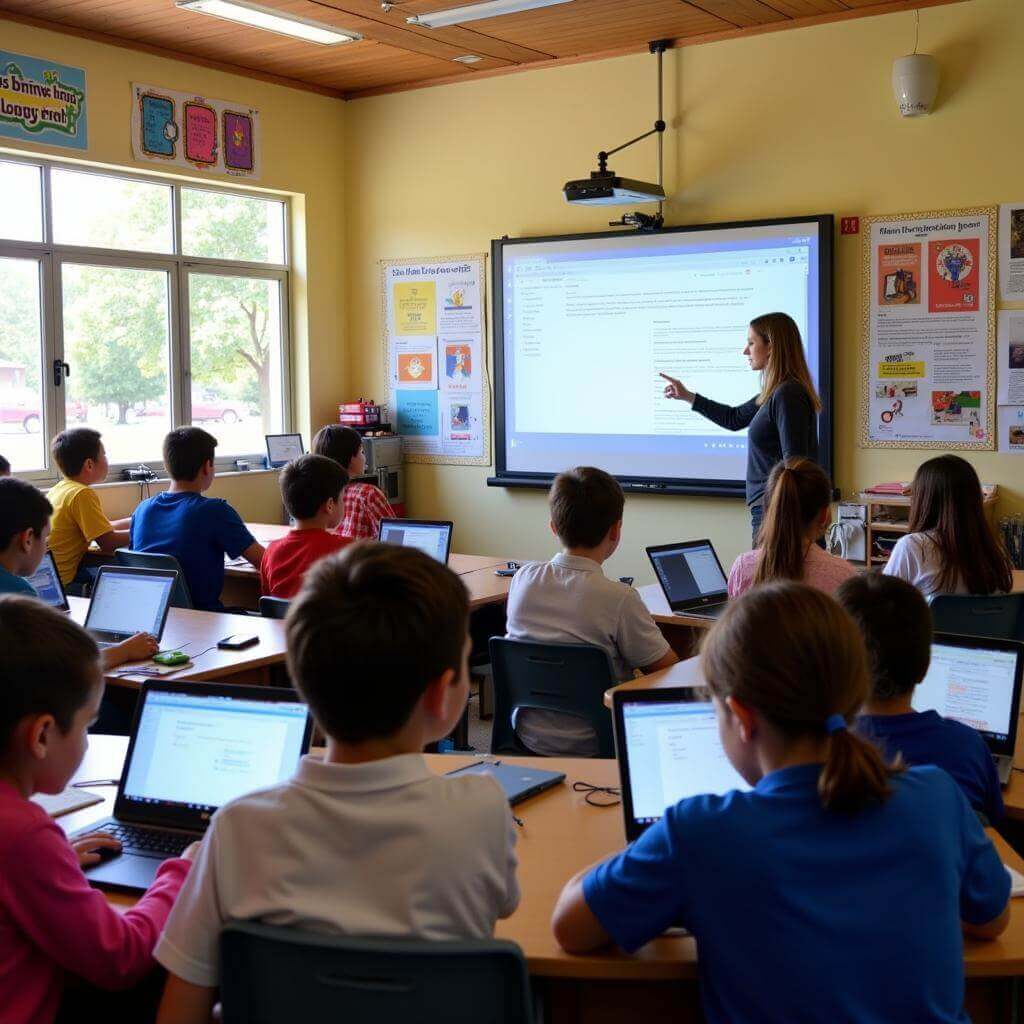The IELTS Reading test can be particularly challenging for STEM learners, who may struggle with the diverse topics and complex language structures. This article provides a sample IELTS Reading test focused on inclusive digital resources for STEM learners, along with detailed answers and analysis.
Nội dung bài viết
- Passage 1 – Easy Text
- The Digital Revolution in STEM Education
- Questions 1-5
- Questions 6-10
- Passage 2 – Medium Text
- Bridging the Gap: Inclusive Digital Resources in STEM Education
- Questions 11-14
- Questions 15-20
- Passage 3 – Hard Text
- The Paradigm Shift: Inclusive Digital Resources Redefining STEM Education
- Questions 21-26
- Questions 27-30
- Questions 31-35
- Answer Key
- Passage 1:
- Passage 2:
- Passage 3:
The role of museums in digital learning has become increasingly important in recent years, especially for STEM education. Let’s explore this topic through a practice IELTS Reading test.
Passage 1 – Easy Text
The Digital Revolution in STEM Education
The landscape of Science, Technology, Engineering, and Mathematics (STEM) education is undergoing a profound transformation due to the advent of digital resources. These innovative tools are revolutionizing the way students learn and interact with complex scientific concepts. From interactive simulations to virtual laboratories, digital resources are making STEM subjects more accessible and engaging for learners of all backgrounds.
One of the key advantages of digital resources in STEM education is their ability to provide inclusive learning experiences. Students with disabilities, those from remote areas, or individuals with different learning styles can now access high-quality STEM education materials that cater to their specific needs. For instance, text-to-speech technology allows visually impaired students to engage with written content, while closed captions on educational videos benefit hearing-impaired learners.
Moreover, digital resources offer unprecedented flexibility in learning. Students can access educational content at their own pace and revisit challenging concepts as often as needed. This self-paced learning approach is particularly beneficial in STEM fields, where understanding foundational concepts is crucial for advancing to more complex topics.
 Inclusive digital resources for STEM education
Inclusive digital resources for STEM education
The gamification of STEM learning through digital platforms has also proven to be highly effective. Educational games and interactive quizzes not only make learning more enjoyable but also help in reinforcing key concepts through repeated engagement. These gamified elements often incorporate real-world scenarios, allowing students to see the practical applications of their learning.
Furthermore, digital resources in STEM education are constantly evolving, keeping pace with the latest scientific discoveries and technological advancements. This ensures that students are always learning with the most up-to-date information and tools, preparing them for the rapidly changing job market in STEM fields.
How digital education platforms showcase cultural artifacts is another interesting aspect of digital learning, often incorporated into STEM education to provide a more holistic understanding of scientific and technological advancements in different cultural contexts.
Questions 1-5
Do the following statements agree with the information given in the passage? Write
TRUE if the statement agrees with the information
FALSE if the statement contradicts the information
NOT GIVEN if there is no information on this
- Digital resources in STEM education are only beneficial for advanced learners.
- Text-to-speech technology helps visually impaired students access written content.
- Digital resources allow students to learn at their own pace.
- Gamification in STEM learning is less effective than traditional teaching methods.
- Digital resources in STEM education are updated regularly to reflect new discoveries.
Questions 6-10
Complete the sentences below.
Choose NO MORE THAN TWO WORDS from the passage for each answer.
- Digital resources are making STEM subjects more ___ and engaging for all learners.
- ___ on educational videos are helpful for hearing-impaired students.
- The ability to revisit challenging concepts is particularly useful in STEM fields, where understanding ___ concepts is essential.
- Educational games often incorporate ___ to show practical applications of learning.
- Constant evolution of digital resources prepares students for the ___ in STEM fields.
Passage 2 – Medium Text
Bridging the Gap: Inclusive Digital Resources in STEM Education
The digital divide has long been a significant barrier in STEM education, particularly affecting students from underprivileged backgrounds and those with disabilities. However, recent advancements in inclusive digital resources are rapidly bridging this gap, offering unprecedented opportunities for all learners to engage with STEM subjects. These innovative tools are not just making STEM education more accessible; they are revolutionizing the very nature of how scientific concepts are taught and understood.
One of the most transformative aspects of inclusive digital resources is their ability to adapt to individual learning needs. Adaptive learning platforms use sophisticated algorithms to analyze a student’s performance and tailor the content accordingly. For instance, if a student struggles with a particular concept in physics, the platform can provide additional explanations, simplified examples, or even alternative learning approaches. This personalized learning experience ensures that each student, regardless of their background or learning style, can progress at their own pace and achieve mastery of STEM concepts.
Cultural influences on the development of digital learning platforms play a crucial role in making these resources truly inclusive, ensuring that they resonate with learners from diverse cultural backgrounds.
Moreover, virtual and augmented reality technologies are opening up new dimensions in STEM education. These immersive experiences allow students to visualize complex scientific phenomena that would be impossible or dangerous to observe in real life. For example, students can take a virtual tour inside a human cell, observe the formation of distant galaxies, or conduct hazardous chemical experiments without any risk. This level of engagement not only enhances understanding but also sparks curiosity and passion for STEM subjects.
 Virtual reality in STEM education
Virtual reality in STEM education
Another critical aspect of inclusive digital resources is their focus on collaborative learning. Online platforms now offer virtual laboratories where students from different parts of the world can work together on STEM projects. This global collaboration not only enhances learning but also prepares students for the increasingly interconnected world of scientific research and development.
The accessibility features of these digital resources are particularly noteworthy. Text-to-speech functionality, customizable color schemes for color-blind users, and sign language interpretation for video content are just a few examples of how these tools are being made inclusive for students with various disabilities. Furthermore, multilingual support ensures that language is not a barrier to accessing high-quality STEM education.
However, the implementation of these inclusive digital resources comes with its own set of challenges. Infrastructure limitations, particularly in rural or economically disadvantaged areas, can hinder access to these advanced learning tools. Additionally, there’s a need for continuous professional development for educators to effectively integrate these resources into their teaching methods.
Despite these challenges, the potential of inclusive digital resources in STEM education is immense. They are not just tools for learning; they are catalysts for creating a more diverse and inclusive STEM workforce. By providing equal opportunities for all students to engage with STEM subjects, these resources are paving the way for a future where innovation and scientific progress benefit from a truly diverse pool of minds and perspectives.
Questions 11-14
Choose the correct letter, A, B, C, or D.
-
What is the main advantage of adaptive learning platforms in STEM education?
A) They provide the same content to all students
B) They focus only on advanced learners
C) They tailor content based on individual student performance
D) They are only suitable for physics education -
How do virtual and augmented reality technologies contribute to STEM education?
A) By replacing traditional classroom learning entirely
B) By allowing visualization of complex scientific phenomena
C) By focusing solely on chemical experiments
D) By eliminating the need for practical experiments -
What is mentioned as a challenge in implementing inclusive digital resources?
A) Lack of student interest
B) Overabundance of resources
C) Infrastructure limitations in certain areas
D) Excessive cost for students -
According to the passage, inclusive digital resources in STEM education are important because:
A) They only benefit students with disabilities
B) They focus exclusively on virtual reality
C) They promote a more diverse STEM workforce
D) They replace traditional teaching methods entirely
Questions 15-20
Complete the summary below.
Choose NO MORE THAN TWO WORDS from the passage for each answer.
Inclusive digital resources are transforming STEM education by making it more accessible to all learners. These resources use 15) to personalize learning experiences. Technologies like virtual and augmented reality allow students to visualize 16) that would be difficult to observe in reality. The resources also promote 17) through online platforms where students globally can work on projects together. For students with disabilities, various 18) are incorporated, such as text-to-speech and customizable color schemes. However, challenges like 19) in some areas can hinder access to these tools. Despite this, these resources are crucial for creating a more 20) in STEM fields.
Passage 3 – Hard Text
The Paradigm Shift: Inclusive Digital Resources Redefining STEM Education
The integration of inclusive digital resources into Science, Technology, Engineering, and Mathematics (STEM) education represents a paradigm shift that is fundamentally altering the landscape of learning and knowledge dissemination. This transformation is not merely a superficial change in educational tools; rather, it signifies a profound reimagining of how STEM subjects are taught, understood, and applied in an increasingly digital world. The ramifications of this shift extend far beyond the classroom, potentially reshaping the future of scientific research, technological innovation, and the global workforce.
At the core of this revolution lies the concept of universal design for learning (UDL), a framework that recognizes and accommodates the vast diversity of learning styles and needs. Inclusive digital resources in STEM education embody the principles of UDL by offering multiple means of representation, action and expression, and engagement. For instance, complex mathematical concepts can now be presented through interactive visualizations, auditory explanations, and tactile simulations, catering to visual, auditory, and kinesthetic learners respectively. This multifaceted approach not only enhances comprehension but also fosters a more inclusive learning environment where students with different abilities and backgrounds can thrive.
The democratization of knowledge is another crucial aspect of this paradigm shift. Historically, access to high-quality STEM education has been limited by geographical, economic, and social factors. Inclusive digital resources are dismantling these barriers, offering world-class educational content to anyone with an internet connection. Massive Open Online Courses (MOOCs) from prestigious institutions, virtual laboratories, and collaborative online platforms are now accessible to students in remote villages and bustling metropolises alike. This democratization is not just about access; it’s about empowering learners to become active participants in their educational journey, fostering a sense of agency and self-efficacy.
 STEM education through augmented reality
STEM education through augmented reality
Moreover, the integration of artificial intelligence (AI) and machine learning in these digital resources is ushering in an era of hyper-personalized learning. AI-driven systems can analyze vast amounts of data on student performance, learning patterns, and engagement levels to create truly adaptive learning experiences. These systems can predict areas where a student might struggle and preemptively offer additional support, or identify topics where a student shows particular aptitude and provide more challenging material. This level of personalization was unimaginable in traditional educational settings and has the potential to dramatically improve learning outcomes across the board.
The gamification of STEM learning through digital platforms is another revolutionary aspect of this paradigm shift. By incorporating elements of game design such as point systems, leaderboards, and narrative structures into educational content, these resources tap into intrinsic motivational factors. This approach not only makes learning more engaging but also helps develop critical problem-solving skills, strategic thinking, and persistence in the face of challenges – all essential qualities for success in STEM fields.
Furthermore, inclusive digital resources are bridging the gap between theoretical knowledge and practical application in STEM education. Virtual simulations and augmented reality experiences allow students to apply theoretical concepts in realistic scenarios, fostering a deeper understanding of how STEM principles operate in the real world. For instance, engineering students can design and test virtual prototypes, experiencing the entire product development cycle without the need for expensive physical materials or equipment.
However, the implementation of these inclusive digital resources is not without challenges. The digital divide remains a significant hurdle, with many students lacking access to the necessary technology or high-speed internet connections. Additionally, there are concerns about data privacy and the ethical use of AI in education, particularly regarding the collection and analysis of student data. The rapid pace of technological advancement also necessitates continuous updating of these resources and ongoing professional development for educators to effectively utilize them.
How education systems address cultural marginalization is an important consideration in the development and implementation of inclusive digital resources, ensuring that these tools are culturally sensitive and relevant to diverse student populations.
Despite these challenges, the potential of inclusive digital resources to revolutionize STEM education is immense. By providing personalized, engaging, and accessible learning experiences, these resources are not just improving educational outcomes; they are reshaping the very nature of STEM education. This paradigm shift has the potential to create a more diverse, innovative, and capable STEM workforce, driving scientific and technological advancements that could address some of the world’s most pressing challenges.
In conclusion, the integration of inclusive digital resources in STEM education represents a transformative force that is democratizing access to knowledge, personalizing learning experiences, and bridging the gap between theory and practice. As these technologies continue to evolve, they promise to create a more inclusive, engaging, and effective STEM education landscape, empowering learners from all backgrounds to contribute to the scientific and technological advancements of the future.
Questions 21-26
Complete the sentences below.
Choose NO MORE THAN TWO WORDS from the passage for each answer.
-
The integration of inclusive digital resources in STEM education represents a ___ that is fundamentally changing how these subjects are taught.
-
The concept of ___ recognizes and accommodates diverse learning styles and needs in education.
-
Inclusive digital resources are dismantling barriers to education, offering world-class content to anyone with an ___.
-
AI-driven systems in digital resources can create ___ learning experiences by analyzing student data.
-
The ___ of STEM learning through digital platforms incorporates elements like point systems and leaderboards.
-
Virtual simulations and augmented reality allow students to apply theoretical concepts in ___, fostering deeper understanding.
Questions 27-30
Do the following statements agree with the information given in the passage? Write
TRUE if the statement agrees with the information
FALSE if the statement contradicts the information
NOT GIVEN if there is no information on this
-
Inclusive digital resources in STEM education cater only to visual learners.
-
MOOCs from prestigious institutions are now accessible to students worldwide.
-
The implementation of inclusive digital resources in STEM education is without any challenges.
-
The use of inclusive digital resources in STEM education could lead to a more diverse and capable workforce in the future.
Questions 31-35
Choose the correct letter, A, B, C, or D.
-
According to the passage, what is a key benefit of universal design for learning in STEM education?
A) It focuses exclusively on visual learners
B) It accommodates diverse learning styles and needs
C) It eliminates the need for traditional teaching methods
D) It is only effective for advanced students -
How are inclusive digital resources contributing to the democratization of knowledge?
A) By limiting access to prestigious institutions
B) By making high-quality educational content widely accessible
C) By focusing only on students in urban areas
D) By replacing all traditional educational methods -
What role does artificial intelligence play in these digital resources?
A) It replaces human teachers entirely
B) It creates standardized learning experiences for all students
C) It enables hyper-personalized learning experiences
D) It is only used for administrative purposes -
What is mentioned as a challenge in implementing inclusive digital resources?
A) The digital divide and lack of access to technology
B) Excessive enthusiasm from students
C) Lack of interest from educational institutions
D) The simplicity of the technology -
According to the passage, how might inclusive digital resources impact the future of STEM?
A) By reducing the need for STEM professionals
B) By creating a more diverse and innovative STEM workforce
C) By eliminating the need for practical experiments
D) By focusing solely on theoretical knowledge
Answer Key
Passage 1:
- FALSE
- TRUE
- TRUE
- FALSE
- TRUE
- accessible
- Closed captions
- foundational
- real-world scenarios
- rapidly changing job market
Passage 2:
- C
- B
- C
- C
- adaptive learning platforms
- complex scientific phenomena
- collaborative learning
- accessibility features
- Infrastructure limitations
- diverse workforce
Passage 3:
- paradigm shift
- universal design for learning
- internet connection


